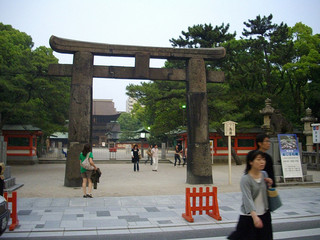Important Cultural Properties
From SamuraiWiki

Sign at Kan'ei-ji in Tokyo, bearing the Bunkachô logo, and identifying the site as containing Important Cultural Properties.
- System Established: 1950
- Japanese: 重要文化財 (juuyou bunkazai)
In 1950, the Japanese government created a new system of cultural heritage, dividing the category of National Treasures - the top tier of sites and objects designated as being of exceptional cultural and historical importance - into an upper tier of National Treasures and a lower tier of Important Cultural Properties.
Important Cultural Properties are more numerous than National Treasures, and are generally considered to be of somewhat less considerable cultural or historical importance. There are currently approximately 12,760 objects & structures registered as Important Cultural Properties, identified by the Bunkachô (Agency for Cultural Affairs) logo, a stylized impression of a pair of hands holding up roof tiles.[1]
Selected List of Important Cultural Properties
Ishikawa prefecture
- Shima teahouse, Higashi Chayagai, Kanazawa - example of geisha house / teahouse machiya architecture
Tokyo
- Agency for Cultural Affairs (Bunkachô):
- Saigyô Hôshi gyôjô-e, handscroll painting by Tawaraya Sôtatsu
- Kan'ei-ji - Eikyûin Mausoleum, Chokugakumon (imperial scroll gate), water basin (suibansha)
- Sensô-ji Nitenmon gate - downgraded from National Treasure in 1950
- Symphony Hall of the Tokyo Music School
- Tokyo National Museum:
- Azekura storehouse of Jûrin-in, Nara
- Gate of the Inshû-Ikeda Residence
- Painting on Zen Enlightenment, panel paintings from hôjô of Daisen-in, attr. Kanô Motonobu
- Ueno Tôshôgû
Kanagawa Prefecture
- Kenchô-ji Butsuden (main Buddha hall)
- Sankeien:
- Gekkaden, formerly of Fushimi castle, built 1603 by Tokugawa Ieyasu
- Pagoda - formerly of Tômyô-ji, Muromachi period, oldest pagoda in the Kantô
- Rinshunkaku - summer home for Kishū Tokugawa family head Tokugawa Yorinobu, 1649, Wakayama
- Shunsôrô tearoom built by Oda Urakusai
- Former main hall of Tômyô-ji, Muromachi period, Kyoto
- Sôgen-ji, Twelve Heavenly Generals (Kamakura period sculptures, representative of Unkei's style)
- Former Yokohama Specie Bank Headquarters - example of Meiji period architecture
Aichi Prefecture

The southeast corner tower at Nagoya castle
- Nagoya castle - the three remaining corner towers, of an original eleven, are designated Important Cultural Properties
Shiga Prefecture
- Hikone castle - various buildings, including Ninomaru Sawaguchitamon-yagura. Main tenshu is a National Treasure.
Nara Prefecture
- Kasuga Shrine:
- Kôfuku-ji Numerous sculptures, incl. Seated Amida Nyôrai sculpture - Kamakura period
Kyoto Prefecture

One of the main gates at Shimogamo Shrine in Kyoto, which is home to 53 Important Cultural Properties
- Byôdô-in - Yôrin'an shoin, moved to the Byôdô-in from Fushimi castle in 1601
- Clarke Memorial Hall at Dôshisha University
- Daitoku-ji Shinju-an - various paintings, works of calligraphy, etc. including works of calligraphy by Daitô Kokushi.
- Ginkaku-ji - entire complex; includes two buildings designated as National Treasures.
- Ninna-ji:
- Shimogamo Shrine - 53 various objects.
Fukuoka Prefecture
- Ichi-no-torii at Hakozaki Shrine, 1609
Okinawa Prefecture
- Engaku-ji - named a National Treasure in 1933; destroyed in 1945. Rebuilt gates and bridge named Important Cultural Property in 1975.
- Sôgen-ji - designated a National Treasure in 1933; destroyed in 1945. Surviving stone walls & gates are today an Important Cultural Property.
References
- Gallery labels and explanatory plaques at various sites.
- ↑ Hyung-il Pai, AAS Roundtable, "Who Moved My Masterpiece?...Cultural Heritage of Kyoto," Association for Asian Studies annual conference, San Diego, March 23 2013.


